Course overview
- Provider
- Domestika
- Course type
- Paid course
- Level
- Beginner
- Deadline
- Flexible
- Duration
- 5 hours
- Lessons
- 28 lessons
- Certificate
- Available on completion
- Course author
- Julio Rojas
-
There are a million and one ways to tell a story and every scriptwriter has his or her own unique technique for doing so. Julio Rojas—the 2012 Goya Award-winning scriptwriter and author—has developed a method he calls the "Script Folder," designed to help you tell a story and tackle the seemingly complex and daunting world of scriptwriting.
Learn techniques, tools, and tricks to turn that story idea in your head into an organic and coherent narrative system, ready to progress to the writing phase.
Description
Start by getting to know Julio, his professional background, and his unique creative process.
Learn about the types of stories and how they relate to and influence the unfolding of each of the story's component parts. Julio shows you how to differentiate a story that has potential from a simple anecdote.
Now it's time to start defining the main plot. Discover how to extract it from within a story and why it is so important for your script. Julio explains the necessity of having a clear narrator and point of view in developing your idea.
Discover the most common types of narrative structures so you can use them in your story. Then learn about the basic components of a script and the narrative triangle.
Once you've got your story defined, focus on one of the most important elements: the characters. Learn to construct them and establish their story arcs, interactions, antagonistic and agonistic dynamics, and conflicts.
Move on from the characters to build the physical universe they live in, as well as some almost invisible objects and implanted elements that act as important information carriers.
Discover some of the main narrative devices, such as temporal alterations, time warp, suspense, surprise, planting, and paradox. Julio also tells you about the concept of dissociation, as well as some hacks for combining components and creating memorable situations.
Learn what a narrative unit, a narrative sequence, and a scene are, as well as their possibilities, types, tips for writing them, and how to differentiate and combine them.
Julio tells you about fundamental script writing rules, then teaches you how to write a scene in a script writing software program.
Get familiar with the concepts of logline, synopsis, outline, and treatment, before applying each of them to your script.
Julio shows you what the first version of your finished script should look like, its format, length, rules, and check criteria before pressing the "Submit" button.
Finally, Julio teaches you how to effectively manage the script folder, so that you can use it as a creative reference tool during the writing process.
Similar courses

-
4 hours
-
19 lessonsCertificate

-
3 hours
-
19 lessonsCertificate


